Bugs Be Gone
Do brown patches dappling your carpet of green have you down? And no amount of fertilizer, seeding or watering takes care of them?
Unfortunately, those brown patches may not mean you have a nutrition or seed problem – they may mean you have unwelcome yard guests…bugs!
Before you run out and purchase a bunch of insecticides, it’s best to know exactly what you are dealing with. No one wants to spend a bunch of money on products that don’t solve the issue.
All turf is going to have some pests. And in moderation, some of these pests can be beneficial to the ecosystem of your lawn. It’s when you have too many of a species that things can go awry.
Pests eat and damage your lawn’s root system, or they can start at the top and work their way down. Either way – it’s a brown situation.
Here are some of Missouri’s biggest culprits you need to watch for.
Fall Armyworm
 The Fall Armyworm starts as a moth, which lays its eggs on leaves in clusters, only to hatch and feed on the above-ground portion of your lawn. An infestation has thepotential to wipe out a lawn in a matter of days.
The Fall Armyworm starts as a moth, which lays its eggs on leaves in clusters, only to hatch and feed on the above-ground portion of your lawn. An infestation has thepotential to wipe out a lawn in a matter of days.
The key characteristic of this combative force is a Y-shaped marking on their head, along with their brownish gray body with green, orange or tan stripes. These crawlers can be anywhere between an inch to an inch-and-a-half.
How do you find them? Take a five gallon bucket to them!
If you add a couple of tablespoons of dishwashing soap to a bucket full of water and pour it over the brown area of your lawn, the larvae will emerge to the surface.
Sod Webworm
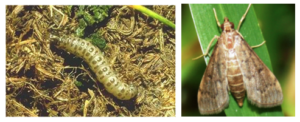 Here we go again, destructive offspring of an innocent looking moth. However, the SodWebworm is much smaller, only about three-quarters of an inch long, and it is tan colored with pairs of brown spots on each body segment.
Here we go again, destructive offspring of an innocent looking moth. However, the SodWebworm is much smaller, only about three-quarters of an inch long, and it is tan colored with pairs of brown spots on each body segment.
Sod webworms often hide under your lawn’s thatch in a silky web-like structure… thus their name sake. If left alone, a crew of sod webworms can wipe out a lawn in the heat of the summer or a drought.
The bucket test can also be applied here for identification. Or, if you get down close to your turf, you may see the appearance of being grazed down or scalped by webworms.
Chinch Bugs
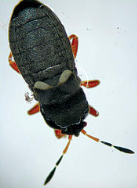 Who knew such an itty bitty guy could do so much damage? These brownish black 3/16” long creepers can devastate a yard.
Who knew such an itty bitty guy could do so much damage? These brownish black 3/16” long creepers can devastate a yard.
The cutthroat chinch bugs feed on the surface, cutting into grass blades with a sharp little mouth, sucking out the sap and leaving behind their toxic saliva—leaving the plant to die (maybe Vampire Bugs would be a more appropriate name). Blades of grass infested with chinch bugs turn yellow before they turn brown, and no amount of water will turn them back.
The bucket test also works for identifying the chinch bug, with the exception of first placing an open ended metal coffee can (or any tube about 6-8” in diameter) down a few inches into the surface of the ground. Then, just pour plain water into the tube. If you have floaters, you may have a problem.
Grubs
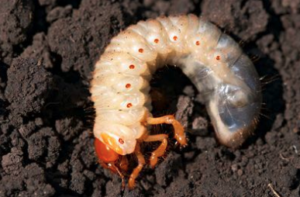 The destruction of a lawn by grubs can be as ugly as they are. Grubs are the larvae of beetles—think June and Japanese beetles to name a couple.
The destruction of a lawn by grubs can be as ugly as they are. Grubs are the larvae of beetles—think June and Japanese beetles to name a couple.
These beetles lay their eggs beneath the surface in early July. The eggs then hatch into white C shaped larvae in late summer and early fall—that’s when you may see irregular brown patches in your yard.
Not only do these creepy pests feed on your lawn’s root system, they also become snacks for area wildlife. While that may seem to be a good thing, unfortunately, the only way wildlife can get to them is by digging. Or worst lawn case scenario, the grubs will attract moles.
If you think grubs may be an issue, you don’t need a bucket, but you will need a spade. Dig just deep enough to look like you are making sod, right under the root system.
While it’s normal to have a few grubs under your turf, any more than five in one square foot patch calls for extermination. The best way to get rid of grubs is to prevent them by using a preventive insecticide in early July before the beetle eggs have a chance to develop.
Earthworms
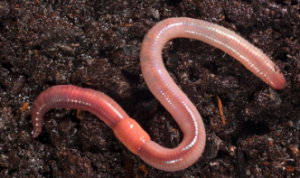 Finally, a friend… or is it? Besides being your favorite fishing partner, earthworms can be very beneficial to your lawn.
Finally, a friend… or is it? Besides being your favorite fishing partner, earthworms can be very beneficial to your lawn.
They eat your dead plant material and produce castings, which are an excellent source of natural fertilizer for your turf. But, as usual, too much of a good thing can be detrimental and the castings can start to burn your lawn.
Not to have to bring up buckets again, but you can wait for a good rain and see what comes up to see if you have too many worms. Or, you might be able to tell by their small piles of castings all over your yard (which, by the way, you can just rake in if you don’t like the sight of them).
You don’t need any chemicals to slim down your earthworm population. Since they love moisture, water your lawn less and let the soil dry out more. You can also rent a lawn roller and roll your yard after a rain to plug up their holes and minimize the mounds they leave behind. Or, you can always go fishing with homegrown bait!
If backing off watering your lawn sounds precarious, then consider this: moles love earthworms. In fact, earthworms are their favorite meal.
Moles
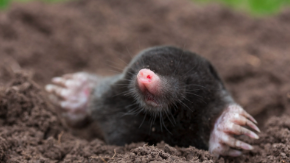 Just the thought of moles in your perfectly groomed turf can send shivers down your spine. Unfortunately, they can go unnoticed until you mow—revealing runway tunnels crisscrossing everywhere, leaving your yard looking like a ball of yarn was set free. Even scarier, those unsightly tunnel makers can dig at a rate of one foot per minute!
Just the thought of moles in your perfectly groomed turf can send shivers down your spine. Unfortunately, they can go unnoticed until you mow—revealing runway tunnels crisscrossing everywhere, leaving your yard looking like a ball of yarn was set free. Even scarier, those unsightly tunnel makers can dig at a rate of one foot per minute!
The best way to terminate these yard wreckers is with a broomstick. Well, that’s where you start at least.
Take a broom handle and stick it down in the tunnels sporadically. Come back after a few hours, and if you see a hole replugged, that can be considered an active tunnel.
In these active tunnels, you will want to set a trap or bait. Be sure to wear gloves when handling the traps so the moles can’t smell human scent—remember, this pest makes a living with its nose.
While controlling turf pests will take more than a bucket and boom, once you’ve identified what kind of pest has invaded your yard, you can create your plan of attack with the correct type of product or tactic. Remember, when using any type of insecticide or other chemicals, carefully follow the directions to keep yourself safe and prevent further damage in your yard.
